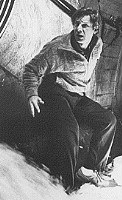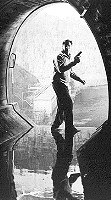

After the success of movies based on such hit '60s TV series as Batman, The Addams Family and even My Mother the Car, it was only a matter of time before some genius Hollywood studio executive hit on the idea of updating for the silver screen the story of Dr. Richard Kimble, which after all commanded the largest television viewing audience of its decade when it reached its climax. On August 6, 1993, Warner Brothers released just such a remake, directed by Andrew Davis, and starring Harrison Ford as the unlucky innocent victim of fate, with Tommy Lee Jones as the new and improved version of his relentless pursuer Gerard — a role for which he was given an Academy Award as Best Supporting Actor.
The screenwriters, Jeb Stuart and David Twohy, mostly concoct a story with a very different thrust from the TV show, but they do pay tribute to the original in a few key places. One of the most suspenseful sequences in the film is borrowed fairly directly from the episode NEVER WAVE GOODBYE; Kimble goes to the county jail to meet with a man who he suspects may be his wife's killer, because he has heard that the man was recently arrested for (one-)armed robbery. Gerard is also checking this man out, and he crosses paths with Kimble in the hallway of the building. As in the TV episode, Gerard is ironically hindered in his attempt to capture Kimble by the very police security measures that are supposed to keep criminals from escaping the jail. The conclusion of this sequence also harks back to the episode of the original series — rather than choreographing the typical flamboyant high-speed chase through the streets, the writers in both cases take a subtle approach, allowing Kimble to escape instead by blending into the ebb and flow of the city.
The ending of the movie revives some additional motifs from the TV show, particularly the part where Kimble trades blows with the man who is really responsible for his wife's death, and angrily demands to know why she had to die, even as the two of them are perched at the edge of a steep precipice (à la THE JUDGMENT). And what remake of The Fugitive would be complete without a scene in which Kimble saves Gerard's life? In the movie, Kimble's chance comes when an evil Eurodude is about to gun down Gerard to ensure his own getaway. But Kimble intervenes in the nick of time.
Interestingly, the screenwriters also pay homage to a source of inspiration that pre-dates the TV series — a source, in fact, that clearly influenced the creators of the original show as well. This source is none other than the French novel Les Misérables by Victor Hugo — like The Fugitive, a tale of a good man unjustly hunted by the police. The chase through underground waterways, which takes place early on in the film, is in fact an unambiguous allusion to the fugitive's daring sewer escape in this novel (or more precisely, in the many screen adaptations of the novel, perhaps most prominently the 1978 TV movie — in the novel itself, the protagonist does in fact escape through the sewers of Paris, but he is not chased by his policeman nemesis, as in the movies; instead, he finds his clever pursuer waiting for him when he emerges). And Stuart and Twohy weave in yet another allusion to the Hugo story almost immediately, as Kimble is seen taking a seemingly suicidal plunge into a body of water to complete his getaway. This idea has its origin in an earlier scene from the novel, where the main character dives off the mast of the warship Orion, thereby liberating himself from a chain gang in the city of Toulon.
Like the TV series, this film also shows the dark side of the police force, insofar as the one-armed man here is an ex-cop, and at the end bad cops want to assassinate Kimble (``take him out'') because he is erroneously thought to be responsible for the murder of a Chicago patrolman (the one-armed man is again the actual culprit). But the pervasive, existential mistrust of the men in blue evoked by the original show is absent from this movie. Here, the closed-minded, corrupt and trigger-happy cops are seen only briefly on the margins (the would-be police assassins at the end are in fact only heard in voice-overs on a radio), while in the TV show, they were the central characters in many episodes.
By contrast, in the movie, a sympathetic cop — the down-home, wise-cracking Deputy Sam — is the real focus, to the exclusion even of the title character. Tommy Lee Jones's marshal is a breed far different from the cold, ferret-like Lieutenant Gerard that Barry Morse brought to life back in the '60s. In his quaint, laid-back Southern drawl, Tommy Lee tells Kimble that he doesn't care about the details of his case; Barry Morse's Gerard obviously pored over every court document obsessively from the start. And even though Tommy Lee is himself a bit trigger-happy (in the county-jail chase, he would have murdered Kimble if it weren't for a fortunately placed slab of bullet-proof glass), this seems like a forgivable excess of a good-natured good ol' boy.
The filmmakers are at their worst when they veer off in their own direction, abandoning the models of the past. They do not even try to recreate the epic scope of the original TV show, which drew out its adventurous story over a span of many years and included a broad panorama of exciting locations. In the movie, all the action seems to take place within the space of a week or two from the time of Kimble's escape, and it's confined exclusively to the city of Chicago and its environs. Nor do the filmmakers dwell on the injustice and existential affront inherent Kimble's situation, the plight of a kind, innocent man who is treated by everyone as if he had done something bestial. Rather, Harrison Ford's Kimble is a strangely passionless individual (not unlike Ford's other bland characterizations in this genre, such as his portrayal of the kidnap victim's husband in Polanski's Frantic); basically he's just a run-of-the-mill action hero trying to evade the authorities.
Instead, the core of this film is its portrait of the team assigned to locate Kimble, headed by Tommy Lee Jones, and these guys spend most of their time on screen engaging in the kind of inane chummy cop banter heard on a zillion hackneyed TV shows. The other main plot strand involves the real murderers of Kimble's wife. The writers of the film wisely choose to abandon the relevant silly plot details from the TV show, but they don't come up with a much better substitute themselves. As it turns out, Kimble's wife was killed as part of a cliche conspiracy whose ringleader is an oily Eurovillain — the same tired old plot element used in nine-tenths of the action movies made in the 1980s. The boring helicopter shots of the Chicago skyline that are constantly inserted at different places in the film — even during the opening murder sequence — seemingly at random, as so much filler, are symptomatic of the movie's vacuousness and lack of ideas.
Tommy Lee Jones went on to film a sequel to this film, but without
the participation of Harrison Ford. Another sequel,
The
Fugitive II, really takes the original story to the next level,
with Kimble this time questing to find the real killer of his
pet dog.
 Back to HOMEPAGE OF THE HUNTED <http://unchance.net/Fugitive>
Back to HOMEPAGE OF THE HUNTED <http://unchance.net/Fugitive>